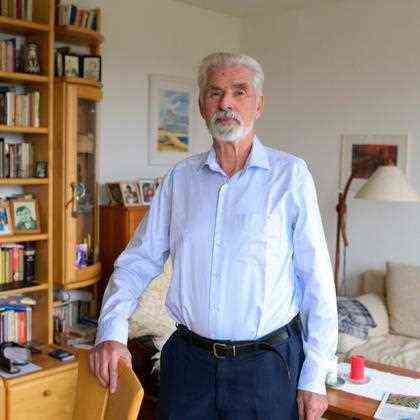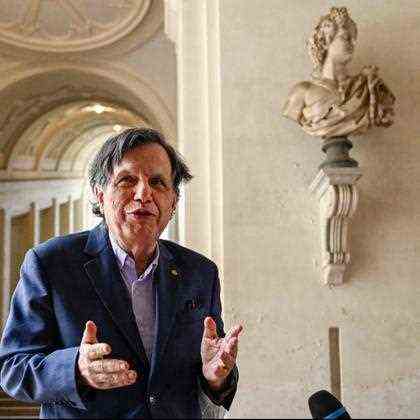Status: 05.10.2021 5:27 p.m.
Klaus Hasselmann, Syukuro Manabe and Giorgio Parisi received the Nobel Prize in Physics for researching so-called complex systems. Your work helps to better understand the climate, for example.
The Nobel Prize in Physics is divided into two parts this year: Climate researchers Klaus Hasselmann and Syukuro Manabe share one half. With their research, they pioneered important climate models that are used today, for example, to reliably predict global warming.
The 89-year-old Hasselmann previously headed the Max Planck Institute for Meteorology in Hamburg and has developed a reliable climate model. In an interview with the daily News he said that he still couldn’t quite believe he’d been awarded the Nobel Prize. He is proud of this award.
Interview with the 2021 Nobel Prize in Physics and climate researcher Klaus Hasselmann
tagesschau24 4:00 p.m., October 5, 2021
The other half of the award goes to the Italian Giorgio Parisi, who is recognized for his basic research on the theory of disordered and random phenomena. Parisi researched which patterns could be hidden in apparently disordered and chaotic structures.
Its results can be transferred to many scientific fields, for example in the study of the climate, its influencing factors and the creation of corresponding forecast models. Parisi’s research made it possible to understand highly complex systems such as the earth’s climate at all. Among other things, he laid the foundations for the work of Hasselmann and Manabe.
Pioneer for current climate models
Both Hasselmann and Manabe were involved in proving that human-made CO2 emissions have a major impact on global warming.
Manabe was able to show how an increased carbon dioxide content in the atmosphere leads to an increase in temperature on the earth’s surface. As early as the 1960s, he began to research the highly complex interactions between atmospheric gases and solar radiation in more detail. With the help of a model, he reproduced for the first time how individual gases, convection currents or even air humidity influence the radiation balance and temperature.
Syukuro Manabe
Syukuro Manabe is a Japanese meteorologist and climatologist. He was born on September 21, 1931 in northwestern Japan.
In 1958 he received his doctorate from the University of Tokyo and then emigrated to the United States. There he worked until 1997 in the general circulation research department of the US Weather Agency. From 1997 to 2001 he went back to Japan to work on the frontier research system for global change. During this time he was director of a research department dealing with the study of global warming.
In 2002 Manabe returned to the United States, where he was a visiting scholar on a research program at Princeton University. He has received numerous awards for his work and contribution in the field of climate research.
Improved weather forecasts
About ten years later, Hasselmann created a computer model that linked weather and climate and showed that climate models are reliable even though the weather fluctuates.
In addition, he developed methods to distinguish between natural phenomena – such as volcanic eruptions – and human influences on the earth’s climate. It was shown that global warming was actually triggered by human greenhouse gas emissions.

Klaus Hasselmann
Klaus Ferdinand Hasselmann is a German climate researcher, meteorologist and oceanologist. He was born on October 25, 1931 in Hamburg. Due to his father Erwin Hasselmann’s journalistic activities, his family emigrated to Great Britain during the National Socialist era.
In 1949 Hasselmann returned to Germany and studied physics and mathematics at the University of Hamburg from 1950 to 1955. He obtained his doctorate in 1957 at the Max Planck Institute for Flow Research in Göttingen. In his doctoral thesis, he described a method for determining the reflection and refraction of shock fronts and any waves of small wavelengths at the interface between two media.
From 1966 he worked as a professor at the University of Hamburg and as a professor at the Scripps Institute for Oceanography in the USA. From 1970 to 1972 he was a professor at the Woods Hole Institute for Oceanography in Massachusetts. In 1975 he returned to Germany, where he worked as a professor at the Institute for Geophysics.
From 1975 to 1999 he worked in Hamburg as director of the Max Planck Institute for Meteorology and from 1988 also as director of the German climate center.
Hasselmann’s research includes wave phenomena in geophysics, stochastic climate models and scientific methods that have been used to prove the human influence on climate change.
The 89-year-old dealt with man-made climate change and the greenhouse effect from an early age. As early as 1988 he said in an interview: “In 30 to 100 years, depending on how much fossil fuel we consume, we will face a very significant climate change. Climatic zones will shift, precipitation will be distributed differently. Then one will no longer be affected by chance results One should be aware that we are entering a situation where there is no turning back. Above all, we have to try to use oil and coal sparingly, because carbon dioxide is largely to blame for the greenhouse effect. “
Parisi and the description of chance
The Italian physicist Parisi has also investigated various phenomena in which random processes play a decisive role, structures arise and develop. He dealt with questions such as: Why do we have periodically recurring ice ages? Is there a more general mathematical description of chaos and turbulence?
Speaking at the award ceremony, Thors Hans Hansson, Chair of the Nobel Prize Committee in Physics said: “The discoveries recognized this year show that our knowledge of climate rests on a solid scientific foundation, the basis of a thorough analysis of observations. This year’s winners have all contributed to giving us a deeper insight into the properties and development of complex physical systems. “
Parisi, who was connected to the announcement by phone, said with reference to the COP26 climate conference, which begins in Glasgow in a few weeks, that he considers the fight against the climate crisis to be extremely urgent. “It is clear that we have to act very quickly for future generations,” said the Italian after the announcement of the Nobel Prize in Physics. It is very important that clear and very powerful decisions are made.

Giorgio Parisi
Giorgio Parisi is an Italian physicist and university professor. He was born in Rome in 1948.
In 1970 he graduated from the University of La Sapienza in Rome with a degree in physics. He then worked as a researcher at the Laboratori Nazionali di Frascati until 1981. As part of his work, he attended various institutes, such as Columbia University in New York (1973-1974), the Insitute des Hautes Etudes Scientifiques in Paris (1976-1977) and the Ecole normal superieure there. From 1981 to 1992 he worked as a professor for theoretical physics at the University “Tor Vergata” in Rome and since 1992 as a professor for quantum physics at the University “La Sapienza”.
Parisi conducts research in various fields of physics, high energy physics, quantum chromodynamics, the theory of phase transitions, statistical mechanics, mathematical physics, string theory and spin glasses. He has been awarded numerous prizes for his research work.

